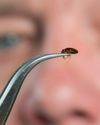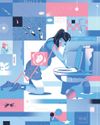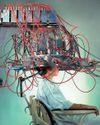For over half a century, women have been able to take control of their bodies to prevent pregnancies. But many men now want to share this responsibility with their partners. So how long will they be waiting for a male pill?

More than 50 years ago, in 1960, the first female hormonal contraceptive pill, Enovid, was approved by the US Food and Drug Administration (FDA), with the UK following in 1961. Just five years later, millions of pills were being popped around the world every day as women took control of their reproductive choices and health, creating a seismic change in society. Today, women have a wide range of reliable, reversible options for controlling their fertility, including intrauterine devices (IUDs), patches, jabs and implants. Men have just two: condoms, which have a 15% failure rate under real-life conditions and are disliked by many couples, and vasectomy – cutting the tubes that shuttle sperm from the testes to the penis. And although vasectomy reversal is possible, it doesn’t always work. So why don’t we have a male pill?
The history of the male contraceptive pill has been a lot more up and down than the female pill. Its origins date back to the 1950s, when US biologist Gregory Pincus, one of the co-inventors of the female pill, found that doses of a synthetic version of the male sex hormone testosterone could switch off sperm production in the same way that the female hormones in the pill shut down ovulation.
“The physiology and science behind the male hormonal contraceptive pill is analogous to the female pill,” explains Prof Stephanie Page, an expert in male reproductive biology at the University of Washington in Seattle. “Giving men an external source of testosterone blocks their own production of the hormone in organs like the testes. They still have plenty of it in their blood, so it doesn’t affect the rest of their body, but developing sperm need 100 to 1,000 times as much testosterone for their final maturation and there just isn’t enough in the testes to enable them to finish developing.”
Sperm-stopper
This story is from the {{IssueName}} edition of {{MagazineName}}.
Start your 7-day Magzter GOLD free trial to access thousands of curated premium stories, and 9,000+ magazines and newspapers.
Already a subscriber ? Sign In
This story is from the {{IssueName}} edition of {{MagazineName}}.
Start your 7-day Magzter GOLD free trial to access thousands of curated premium stories, and 9,000+ magazines and newspapers.
Already a subscriber? Sign In

TAKE IT SLOW
Slow running is a fitness trend with some hard and fast science behind it

Physics, AI and music share a common thread. You just have to know where to look
Studying science can lead you in many directions and open doors to unexpected possibilities along the way

BED BUGS VS THE WORLD
When bloodthirsty bed bugs made headlines for infesting Paris Fashion Week in 2023, it shone a spotlight on a problem that's been making experts itch for decades: the arms race going on between bed bugs and humans

Kids are the key to understanding obesity. But we need more of their genes...
We can unravel the role that bodyweight plays in disease, but we need a bigger, more diverse, sample of genetic material to do so

COVID inquiry: What did we learn and what can we do better in future pandemics?
Masks, social distancing, lockdowns... how effective was the UK's response to the COVID-19 pandemic?

One hormone could be the key that unlocks a cure for morning sickness
The nausea and vomiting that, in extreme cases, can endanger mothers and babies might soon be just a memory

THE WORLD'S WEIRDEST CREATURES
Under the sea and upon the land, some animals look - to us - pretty strange...

WHEN MIND AND MACHINE COLLIDE
First, Elon Musk wanted to make electric cars ubiquitous, then he wanted to make space exploration a private enterprise. Now, with Neuralink, his newest venture, Musk hopes to merge humans and artificial intelligence. Turns out, it might not be such a crazy idea...

COME OUT OF YOUR SHELL
Social anxiety is more than just being shy. It's a phobia born out of our evolutionary past. But that raises a puzzling question: why do so many of us fear human interaction when we're supposed to be the most sociable species on the planet?

SPACE ODDITIES
Take a tour of the weirdest spots in the universe, where the 'normal' rules don't apply. Places that squeeze time, blow bubbles and even rain glass... sideways